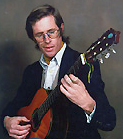 Hannemann’s Music Corner: Living Things
Hannemann’s Music Corner: Living ThingsBy RICHARD HANNEMANN
Friday April 19, from 5-7 p.m., the Karen Wray Studios will present an exhibition entitled “Living Things.”
I will be providing the music, which makes sense given that instruments are living things as well.
Never thought of it that way?
Back in the day, when I lived in the LA Apartments (1971-ish), I had a Lyle classical guitar.
I’ve always been a bit fortunate in the guitars I’ve owned – in terms of the quality of their voice – and this Lyle, my first classical, was no exception. The tone was rich and mellow with good projection across the dynamic range.
A friend across the hall also had a Lyle. One day he remarked that mine sounded much better than his. He thought this might be the player rather than the guitar and asked me to try it out. Turned out to be the guitar, which had a rather soft voice slightly on the tinny side.
Thinking it might have to do with the date of manufacture, we looked at the imprint page inside the guitar. His guitar had a serial number just 4 counts off from mine. But the wood was decidedly different – my top had a tighter, straighter grain than his which at least explained some of it.
Had either of us known more we might have looked at the kerbing, the bracing, the bridge placement, and other aspects of guitar building that can make a difference.
But there is something else.
A guitar, a violin, a cello, a clarinet (wood) are instruments made from living things – trees. Every tree, as with every living thing, is unique unto itself. It has its own life history portrayed in its rings which become the grain of the wood from which an instrument is made.
That life history is influenced by a multitude of factors. Two trees standing together in a forest can grow very differently depending on variations of light, moisture, and nutrients in the earth. These variables can impact the cellular structure, and most importantly for our purposes, the cellular alignment of the wood.
So the sound of the instrument you are playing is the result of craftsmanship plus the life history of the tree(s) from which the materials came. And more …
Sound is vibration moving through and acting on a medium. That would include the material from which the instrument is made. It seems likely that, over time, as the instrument is played the sound vibrations in the body will alter the structure and alignment at the cellular level.
If so, then the instrument will begin to be influenced by the styles and types of music it plays.
Every tone has its own fundamental frequency as well as an over-tone series (though its own subject, the over-tone series is still the reason why analog is much better than digital for recording music – besides we have analog ears, not digital.)
Different playing styles and different music styles will tend to emphasize certain frequencies over others and those frequencies will act on the materials in differing ways.
Since the music you play is one of personal preference, that would suggest that when you play an instrument you are imparting to it a portion of your own personality.
The longer you play the particular instrument, the greater the cumulative effect. Since what we play and how we play it is a matter of personal considerations and those considerations are a result of our own life-history, the result is a blending of your life with the life of the tree(s) from which your instrument was made.
This may well apply to brass and silver instruments as well. The ore mined will reflect its own life-history based upon influences of its formation – pressure, surrounding material, impurities (which you can’t get out 100 percent – thus influencing the manner in which the sound vibrations act on, in, and through the instrument.
Here, again, the player’s choices in musical styles and playing could, over time and usage, influence the structure of the instrument in a manner which reflects the unique character and personality of the player.
To complete, the choice of string or reed (and perhaps mouthpiece) will tend to emphasize certain of the over-tones within a range over others for each fundamental, again creating a frequency pattern which then imparts to the instrument.
It is, perhaps, an animistic fancy and somewhat akin to discussions of the existence of a soul.
But I find myself believing, and believing rather as a leap of faith rather than empirical proof thus to more greatly respect and cherish for believing, that an instrument truly is a living thing, that it becomes a reflection and extension of the music played and the person(s) playing it, that it has a story to tell of its life-history as instrument and pre-instrument, which story is told with its every sounding, and that when someone says, “wow, that player can really make that instrument talk” they may be much closer to the truth than they know.

